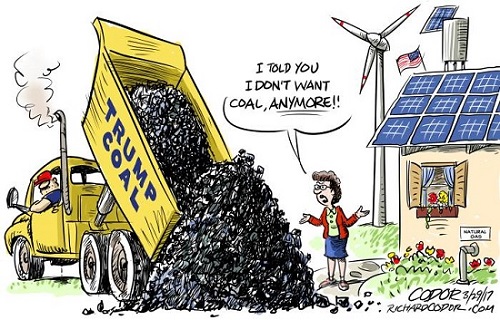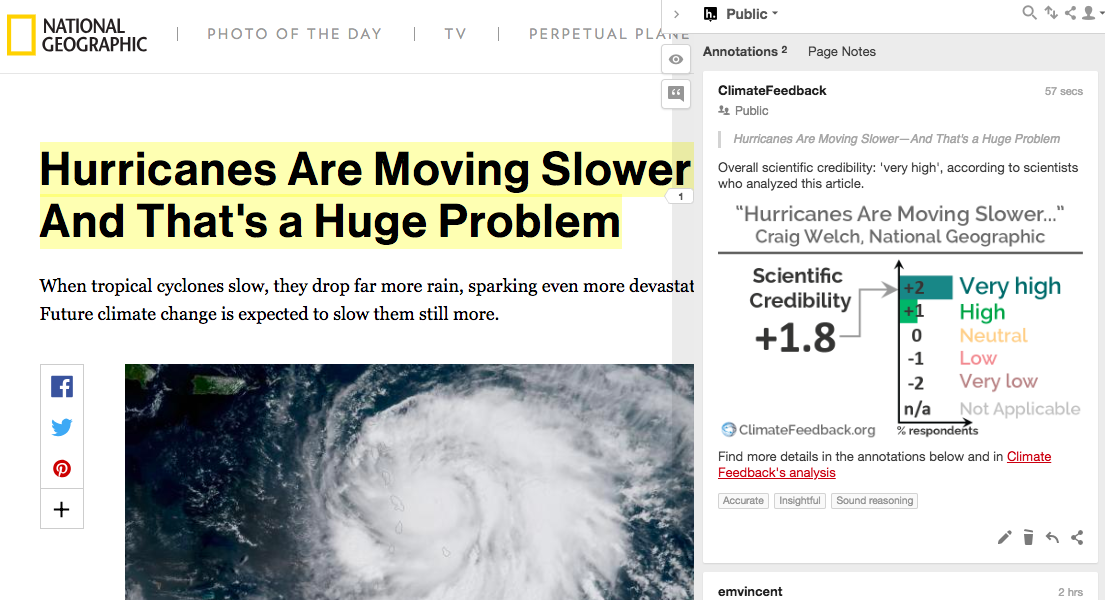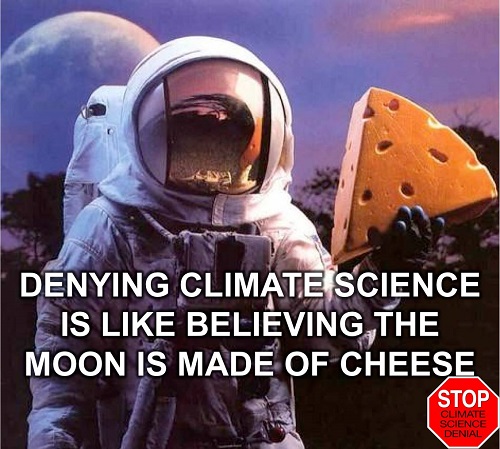2018 SkS Weekly Climate Change & Global Warming Digest #23
Posted on 10 June 2018 by John Hartz
Story of the Week... Toon of the Week... SkS Spotlights... Video of the Week... Coming Soon on SkS... Climate Feedback Reviews... SkS Week in Review... Poster of the Week...
Story of the Week...
We are almost certainly underestimating the economic risks of climate change
The models that inform climate policymaking are fatally flawed.

One of the more vexing aspects of climate change politics and policy is the longstanding gap between the models that project the physical effects of global warming and those that project the economic impacts. In a nutshell, even as the former deliver worse and worse news, especially about a temperature rise of 3 degrees Celsius or more, the latter remain placid.
The famous DICE model created by Yale’s William Nordhaus shows that a 6-degree rise in global average temperature — which the physical sciences characterize as an unlivable hellscape — would only dent global GDP by 10 percent.
Projections of modest economic impacts from even the most severe climate change affect climate politics in a number of ways. For one thing, they inform policy goals like those President Obama offered in Paris, restraining their ambition. For another, they fuel the arguments of “lukewarmers,” those who say that the climate is warming but it’s not that big a problem. (Lukewarmism is the public stance of most Trump Cabinet members.)
Climate hawks have long had the strong instinct that it’s the economic models, not the physical-science models, that are missing something — that the current expert consensus about climate economic damages is far too sanguine — but they often lack the vocabulary to do any more than insist.
As it happens, that vocabulary exists. At this point, there is a fairly rich literature on the shortcomings of the climate-economic models upon which so much political weight rests. (Here’s an old post of mine from 2015 bashing them.)
Two recent papers help simplify and summarize that literature. They are addressed to different audiences (one the US, one the international community), but both stress the importance of improving these lagging models before the next round of policymaking. I’ll touch on the US-focused one first, the international one second.
We are almost certainly underestimating the economic risks of climate change by David Roberts, Energy & Environment, Vox, June 9, 2018
Toon of the Week...

SkS Spotlights...
Independent news on research in the Nordic countries

ScienceNordic, launched in November 2011, is the trusted English-language source for science news from the Nordic countries.
We cover science in the broadest sense – the human sciences as well as natural science, health and technology.
ScienceNordic is the result of a joint effort from two well-established science news services, Forskning.no in Norway and Videnskab.dk in Denmark, which work in close collaboration with partners in Sweden, Finland, Iceland, Greenland, the Faroe Islands and Åland.
Our team of experienced science reporters and editors follow the regional scientific communities closely and report on the latest and greatest discoveries.
Videnskab.dk and Forskning.no are both highly regarded, award-winning science news services, published in Danish and Norwegian respectively. Both disseminate national and international science news through their independent editorial offices.
Our content is targeted toward the global research community: researchers, students, the business sector, innovation clusters, international institutions and media – along with anybody else with an interest in science.
Content from Forskning.no and Videnskab.dk may be made available in English on ScienceNordic, and content produced for ScienceNordic may similarly be published in the local languages on Forskning.no and Videnskab.dk.
ScienceNordic is published online and is available to all.
Video of the Week...
Why chronic floods are coming to New Jersey
Sea level rise will have a profound impact on coastal infrastructure because it’s often built on cheaper, low-elevation land. As sea level rises, the systems that support the densely populated, urban areas — power generation facilities, wastewater treatment plants, and miles of transportation networks — will be at greater risk of flooding.
Significant portions of the US’s eastern coast are also sinking, due to an ancient, melting glacial ice sheet and the subsidence of its bedrock.
The video above details the impacts an accelerated rising sea level will have on the greater New York City metropolitan region.
Why chronic floods are coming to New Jersey by Carlos Waters, Videos, Vox, June 4, 2018
Coming Soon on SkS...
- The Wall Street Journal is peddling Big Oil propaganda (Dana)
- Wally Broeker: Father of “Global Warming”, in a Warning to his Granddaughter (greenman)
- Life after PhD (Climatesight Kate)
- Guest Post (John Abraham)
- New research this week (Ari)
- 2018 SkS Weekly Climate Change & Global Warming News Roundup (John Hartz)
- 2018 SkS Weekly Climate Change & Global Warming Digest (John Hartz)
Climate Feedback Reviews...
National Geographic accurately covers research pointing to slower-moving hurricanes

Climate Feedback asked a team of scientists to review the article, Hurricanes Are Moving Slower—And That's a Huge Problem by Craig Welch, National Geographic, June 6, 2018
Four scientists analyzed the article and estimate its overall scientific credibility to be 'very high'.
A majority of reviewers tagged the article as: Accurate, Insightful, Sound reasoning.
Review Summary
This National Geographic article covers a result reported in two recent studies: global warming seems to be causing the movement rate of hurricanes to slow. One study shows this trend in data going back to about 1950, while the other simulates hurricanes in an even warmer world using a climate model. While the process responsible for this trend needs to be studied further, it could be due to a general slowing of windsin areas where hurricanes exist due to differences in warming rate between low and high latitudes.
Scientists who reviewed the article concluded that it does a good job of placing the finding in context and asking input from scientists with expertise on the topic for validation.
National Geographic accurately covers research pointing to slower-moving hurricanes, Edited by Scott Johnson, Climate Feedback, Jun 8, 2018
SkS Week in Review...
- 2018 SkS Weekly Climate Change & Global Warming News Roundup #23 by John Hartz
- New research, May 28 - June 3, 2018 by Ari Jokimäki
- Tiny shrimp could influence global climate changes by John Abraham (Climate Consensus - the 97%, Environment, Guardian)
- Climate Science blogs around the world by BaerbelW
- New Video: Hot Ocean, Hurricanes, Houston, and Harvey by greenman360 (Climate Crocks of the Week with Peter Sinclair)
- The latest weak attacks on EVs and solar panels by Dana Nuccitelli (Climate Consensus - the 97%, Environment, Guardian)
- 2018 SkS Weekly Climate Change & Global Warming Digest #22 by John Hartz
Poster of the Week...
































 Arguments
Arguments






























It must become understood that future generations are "Others". The future is not "Our Future", and the present is not "Their Present".
It also must be understood that it is morally/ethically unacceptable to try to benefit in a way that can be understood to be causing harm to Others.
And an undeniable understanding is that many pursuits of personal benefit among today's generation are causing harm to the future generations.
That leads to understanding that pursuing a better present to the detriment of the future is inexcusable.
That means there is no economic justification for any already fortunate people to continue benefiting from burning of non-renewable buried ancient hydrocarbons. Only the least fortunate should benefit, and only temporarily, and only if burning fossil fuels produces a significant to benefit the poorest (very temporarily).
Economic analysis attempting to balance 'lost opportunity for benefit today if the harmful burning is stopped' with 'the magnitude of negative impacts in the future' is undeniably absurd excuse making, yet remains popular among supposedly more advanced and educated people.
Self-interest can have a powerful negative affect on thinking.
The article on economic modelling is persuasive. But do these economic models do a cost benefit analysis over the next 100 years, or do they consider costs over 1000 years, which is the time frame of the most significantly elevated CO2 levels? It would seem to me a 1000 year period of more destructive weather globally would be a pretty massive total cost. I don't think we could limit the studies to just this generation of people (picking up on what OPOF said)
How would you even put an economic cost on animal species extinctions, loss of habitat, ocean acidification etc? Yet these are all intuitively negative sorts of consequences.
I have total respect for people trying to model all this, because its obviousy exceptionally complicated with so many factors to consider. It may be a case of trying to think more widely than economic modelling. There are many reasons to reduce carbon footprints in addition to crude cost factors, we will run out of fossil fuels anyway, etcetera. This is how I rationalise it all.
Cost-benefit analysis is not required to show the stupidity of the DICE model (a 6-degree rise in global average temperature — which the physical sciences characterize as an unlivable hellscape — would only dent global GDP by 10 percent). Nor is it needed to realise that a rise in temperature of >2°C by 2100 producing severe climate conditions, partial collapse of agriculture and sea level rise flooding some major coastal cities could to have a negative effect of more than 10% on global GDP.
Continuing increase in the incidence of infrastructure damage through fire and severe climate events is also likely to occur and contribute to GDP contraction. Such outcomes, accompanied by expected increase in global population to >11 billion by 2100 is likely to result in starvation in some parts of the world and uncontrolled, possibly violent population movement in others.
We live in ‘interesting times’ yet do far too little to avoid catastrophic outcomes, while debating the merits of cost benefit analysis as a prognostic tool. Bit like the 14th century when some debated the number of angels who could stand on the point of a needle while the Black Death raged throughout Europe killing 60 % of the entire population.
The 'Dice' economic model predicts a 10% reduction in economic output. Summary of the dice model here. While the model does not appear to have some hidden agenda, even just a brief examination of the summary shows some considerable oddities:
1) I can't see any reference to quantifiyng the effects of climate refugees. Clearly with higher temperature scenarios this could become a huge economic issue like Riduna says. Regardless of effects on gdp growth, this has a range of other effects such as on house prices and road congestion.
2) The Dice study assumes population at 8.6 billion by 2100 which seems odd to me, because all the estimates I have read suggest 11 billion is the most likely number.
3) The Dice study assumes fatalities from heatwaves and reduced winter cold will cancel out. This seems optimistic to me given 1)the serious and yet very plausible scenarios for increased heatwaves and 2) the argument that deaths from winter cold are largely related to people congregating inside, so transmission of infections, and this is something that would not change much even in a warming climate.
4) It's very hard to reconcile even middle range estimates for increased hurricanes and flooding, and only a 10% reduction in economic output.
5) Dice assumes on advice of experts of a 6.8% chance at 6 degrees of 'catastrophic' climate change (defined as a 25% reduction in economic output on a near permanent basis. My note - this equates to the reduction during the 1930s great economic depression). The climate science field is moving quickly, and this looks like a totally outdated and conservative figure, but its still not partcularly good odds even at 6.8%, especially given the disastrous potential economic consequences.
6) No price appears to be put on species decline. But animal and plant species have economic value particularly the pharmaceutical industry.
7) No obvious recognition of realistic future economic growth trends. Economists mostly assume gdp growth will just continue at good rates and the dice study almost certainly assumes this, but reality suggests this is far too optimistic. Economic growth is already slowing, and has fallen from 6% in the 1950's to about 3% now in western countries, and there are convincing reasons to think we are heading to a world of zero economic growth this century. So in a world of static economic output, any reduction due to climate change will hurt even more.
Related to my previous comments. Looks like the DICE study was even more wrong in claiming deaths from heat waves are cancelled out by fewer deaths from cold: "Climate skeptics sometimes like to claim that although global warming will lead to more deaths from heat, it will overall save lives due to fewer deaths from cold. But is this true? Epidemiological studies suggest the opposite."
Studies like the DICE study appear to fail to recognize (perhaps deliberately) that any economic activity that is unsustainable (like the consumption of non-renewable resources or creation of accumulating environmental impacts) will have no future value and create no lasting value, only create negative future impacts.
The assumptions of continued growth presume something that will justify the growth will always exist.
In the 1960s, as the ability to extract wealth from non-renewable resources in less powerful nations was starting to become a little more difficult, increased consumer debt became a major tool to boost the appearance of economic growth.
An increase in consumer debt, or an increase in the ability to extract wealth from non-renewable resources somewhere cheaper than has been available in the past, is not available into the future. And developed activities that create accumulating environmental impact need to be curtailed.
There is little justification for the hope of continued growth just because there has been a history of growth so far. The ability of the more fortunate to extract even more benefit from unsustainable activities appears to have reached the point where a careful climb-down was required decades ago (the 2008 debt-triggered crash was a warning that things have already developed too far in the wrong direction).
Unfortunately, popularity and profitability can be seen to lead to development that favours the members of the current generation of humanity to the detriment of the future generations. It also develops more benefit for the already more fortunate. Global wealth has risen faster than population - though admittedly they are unsustainable perception of wealth - yet many still suffer brutal short existences. And the divide between the richest and poorest has increased (which is another unsustainable direction of development).